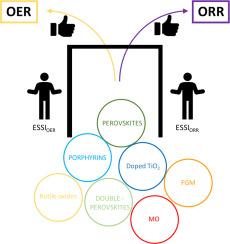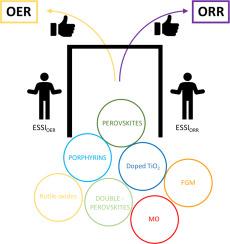研究了氧还原反应和进化反应的电化学对称性
IF 5.6
3区 材料科学
Q1 ELECTROCHEMISTRY
引用次数: 0
摘要
析氧反应(OER)和氧还原反应(ORR)显示出相当大的过电位,即使是最先进的活性催化剂。这阻碍了许多电化学技术的技术经济可行性,如低温氢燃料电池、水和二氧化碳电解槽、再生燃料电池和金属-空气电池。虽然吸附-能量标度关系与较大的OER/ORR过电位有关,但它们的破坏并不能保证活性的增强。另外,电化学对称性与OER过电位有关。本文推导了OER电化学对称性与ORR电化学对称性的关系式。该公式解释了当ESSIOERESSIOER和ESSIORRESSIORR相关联时产生的明显趋势,斜率由高于平衡势的反应步数定义。此外,我们使用了包括各种电催化剂家族在内的168种材料的数据集,以简单的方式统计提取联合OER/ORR活性趋势。本文章由计算机程序翻译,如有差异,请以英文原文为准。


The electrochemical symmetries of the oxygen reduction and evolution reactions are connected
The oxygen evolution reaction (OER) and the oxygen reduction reaction (ORR) display sizable overpotentials, even for active state-of-the-art catalysts. This hurdles the technoeconomic viability of a number of electrochemical technologies such as low-temperature hydrogen fuel cells, water and CO2 electrolyzers, regenerative fuel cells, and some metal-air batteries. While adsorption-energy scaling relations have been associated with the large OER/ORR overpotentials, their breaking does not ensure enhanced activities. Alternatively, electrochemical symmetry is connected to the OER overpotential. Herein, we derive a formula connecting the OER electrochemical symmetry with that of the ORR. The formula explains the distinct trends arising when and are correlated, and the slopes are defined by the number of reaction steps above the equilibrium potential. Furthermore, we use a dataset of 168 materials including various families of electrocatalysts to statistically extract joint OER/ORR activity trends in simple terms.
求助全文
通过发布文献求助,成功后即可免费获取论文全文。
去求助
来源期刊

Electrochimica Acta
工程技术-电化学
CiteScore
11.30
自引率
6.10%
发文量
1634
审稿时长
41 days
期刊介绍:
Electrochimica Acta is an international journal. It is intended for the publication of both original work and reviews in the field of electrochemistry. Electrochemistry should be interpreted to mean any of the research fields covered by the Divisions of the International Society of Electrochemistry listed below, as well as emerging scientific domains covered by ISE New Topics Committee.
 求助内容:
求助内容: 应助结果提醒方式:
应助结果提醒方式:


